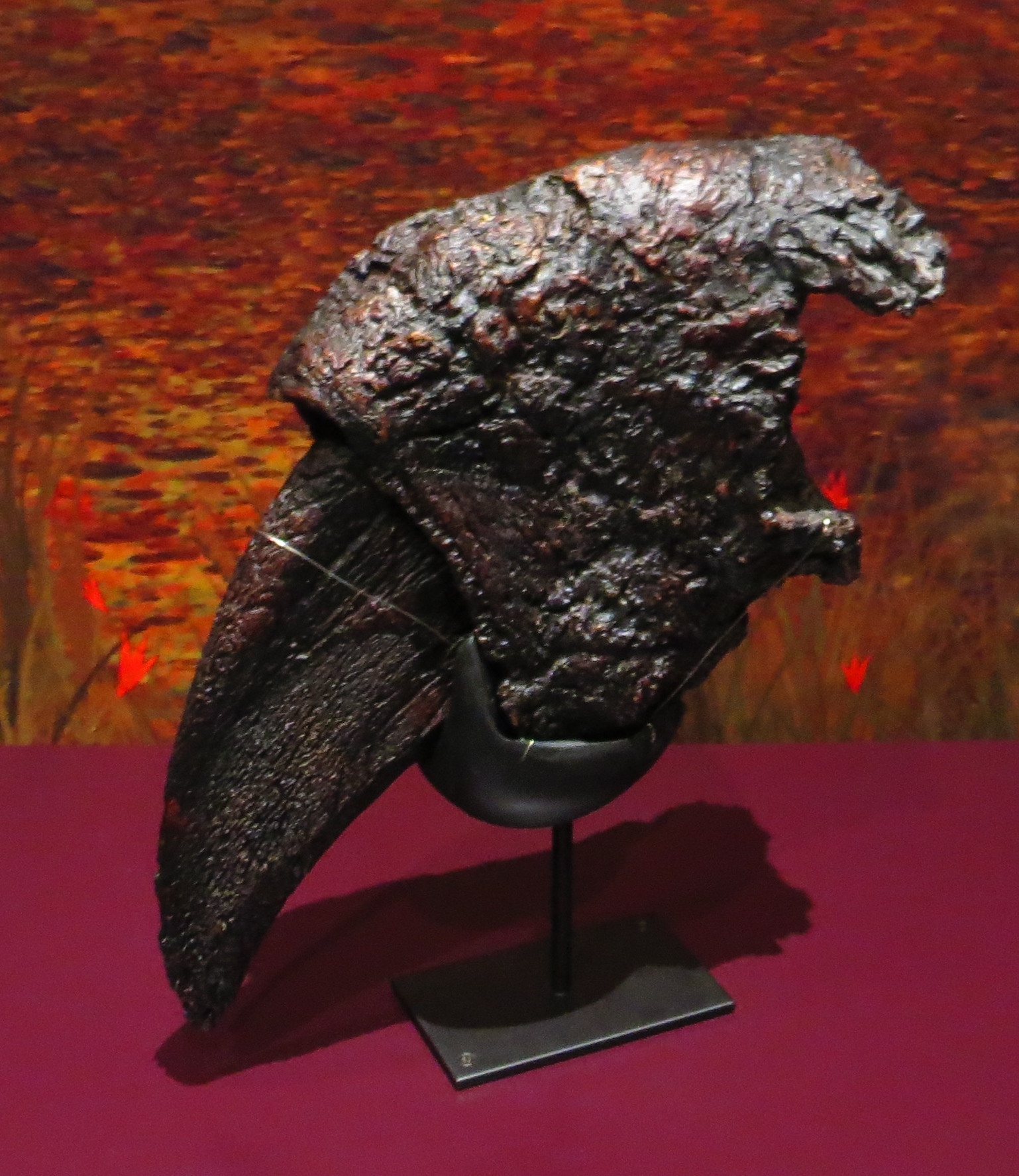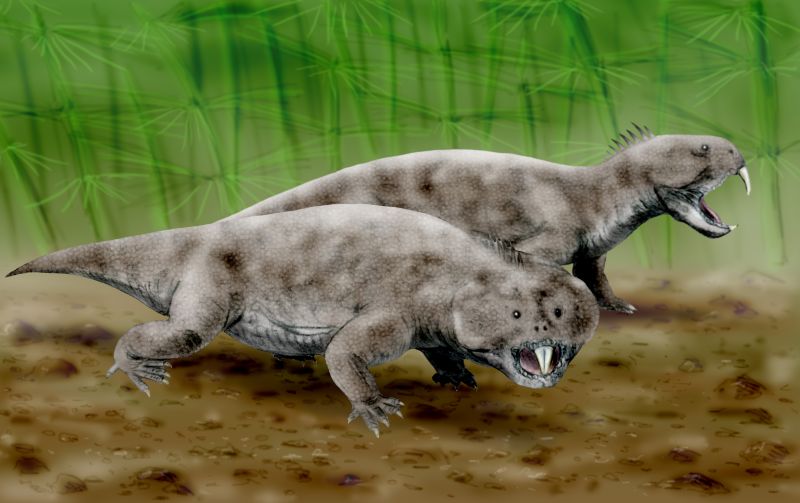|
Teraterpeton
''Teraterpeton'' (meaning "wonderful creeping thing" in Greek (language), Greek) is an extinct genus of trilophosaurid archosauromorphs. It is known from a partial skeleton from the Late Triassic Wolfville Formation of Nova Scotia, described in 2003. It has many unique features seen in no other related form, including an elongated, toothless snout and large openings for the nostrils. Because of this, ''Teraterpeton'' was originally placed in its own family (biology), family, Teraterpetidae, related to ''Trilophosaurus''. Newer studies generally place it within Trilophosauridae. Description Skull ''Teraterpeton'' had an unusual appearance compared to other early archosauromorphs. Members of the genus had a long skull with no teeth at the ends of the upper and lower jaws. Over each eye socket is a bony projection formed by the lacrimal bone, lacrimal and prefrontal bones. At the back of the jaws are a set of small, sharp, closely spaced teeth. They continue below the level of t ... [...More Info...] [...Related Items...] OR: [Wikipedia] [Google] [Baidu] |
Wolfville Formation
The Wolfville Formation is a Triassic geologic formation of Nova Scotia. The formation is of Carnian to early Norian age. Fossils of small land vertebrates have been found in the formation, including procolophonid and early archosauromorph reptiles and cynodonts. Dinosaur remains are among the fossils that have been recovered from the formation, although none have yet been referred to a specific genus.Weishampel, et al. (2004). "Dinosaur distribution." Pp. 517-607. Vertebrate fauna Synapsids Archosauromorphs Procolophonids See also * List of dinosaur-bearing rock formations This list of dinosaur-bearing rock formations is a list of geologic formations in which dinosaur fossils have been documented. * List of stratigraphic units with dinosaur body fossils * List of stratigraphic units with dinosaur trace fossils ** ... ** List of stratigraphic units with indeterminate dinosaur fossils References Bibliography * Geologic formations of Nova Scotia ... [...More Info...] [...Related Items...] OR: [Wikipedia] [Google] [Baidu] |
Trilophosaurid
Trilophosaurs are lizard-like Triassic allokotosaur reptiles related to the archosaurs. The best known genus is '' Trilophosaurus'', a herbivore up to long. It had a short, unusually heavily built skull, equipped with massive, broad flattened cheek teeth with sharp shearing surfaces for cutting up tough plant material. Teeth are absent from the premaxilla and front of the lower jaw, which in life were probably equipped with a horny beak. The skull is also unusual in that the lower temporal opening is missing, giving the appearance of a euryapsid skull, and originally the Trilophosaurs were classified with placodonts and sauropterygia. Carroll (1988) suggests that the lower opening may have been lost to strengthen the skull. Trilophosaurs are so far known only from the Late Triassic of North America and Europe. Below is a cladogram A cladogram (from Greek language, Greek ''clados'' "branch" and ''gramma'' "character") is a diagram used in cladistics to show relatio ... [...More Info...] [...Related Items...] OR: [Wikipedia] [Google] [Baidu] |
Late Triassic
The Late Triassic is the third and final epoch (geology), epoch of the Triassic geologic time scale, Period in the geologic time scale, spanning the time between annum, Ma and Ma (million years ago). It is preceded by the Middle Triassic Epoch and followed by the Early Jurassic Epoch. The corresponding series (stratigraphy), series of rock beds is known as the Upper Triassic. The Late Triassic is divided into the Carnian, Norian and Rhaetian Geologic time scale, ages. Many of the first dinosaurs evolved during the Late Triassic, including ''Plateosaurus'', ''Coelophysis'', ''Herrerasaurus'', and ''Eoraptor''. The Triassic–Jurassic extinction event began during this epoch and is one of the five major mass extinction events of the Earth. Etymology The Triassic was named in 1834 by Friedrich August von Namoh, Friedrich von Alberti, after a succession of three distinct rock layers (Greek meaning 'triad') that are widespread in southern Germany: the lower Buntsandstein (colourful ... [...More Info...] [...Related Items...] OR: [Wikipedia] [Google] [Baidu] |
Hans-Dieter Sues
Hans-Dieter Sues (born 1956) is a German-born American palaeontologist who is a Senior Research Geologist and Curator of Vertebrate Paleontology at the National Museum of Natural History of the Smithsonian Institution in Washington, DC. Career Sues attended the Johannes Gutenberg-Universität Mainz ( University of Mainz), the University of Alberta, and Harvard University (Ph.D., 1984). He did work at McGill University and was a research paleobiologist at the Smithsonian before taking a role at the Royal Ontario Museum, where he was vice-president of collections and research. In 1998, Sues was elected a Fellow of the American Association for the Advancement of Science. In 2002, he moved to the Carnegie Museum of Natural History, becoming their curator of vertebrate paleontology. From 2002 to 2004, he was also the president of the Society of Vertebrate Paleontology. In 2003, Sues was elected a Fellow of the Royal Society of Canada. In 2010, he was awarded an Alexander von Humb ... [...More Info...] [...Related Items...] OR: [Wikipedia] [Google] [Baidu] |
Cervical Vertebrae
In tetrapods, cervical vertebrae (: vertebra) are the vertebrae of the neck, immediately below the skull. Truncal vertebrae (divided into thoracic and lumbar vertebrae in mammals) lie caudal (toward the tail) of cervical vertebrae. In sauropsid species, the cervical vertebrae bear cervical ribs. In lizards and saurischian dinosaurs, the cervical ribs are large; in birds, they are small and completely fused to the vertebrae. The vertebral transverse processes of mammals are homologous to the cervical ribs of other amniotes. Most mammals have seven cervical vertebrae, with the only three known exceptions being the manatee with six, the two-toed sloth with five or six, and the three-toed sloth with nine. In humans, cervical vertebrae are the smallest of the true vertebrae and can be readily distinguished from those of the thoracic or lumbar regions by the presence of a transverse foramen, an opening in each transverse process, through which the vertebral artery, verteb ... [...More Info...] [...Related Items...] OR: [Wikipedia] [Google] [Baidu] |
Scapula
The scapula (: scapulae or scapulas), also known as the shoulder blade, is the bone that connects the humerus (upper arm bone) with the clavicle (collar bone). Like their connected bones, the scapulae are paired, with each scapula on either side of the body being roughly a mirror image of the other. The name derives from the Classical Latin word for trowel or small shovel, which it was thought to resemble. In compound terms, the prefix omo- is used for the shoulder blade in medical terminology. This prefix is derived from ὦμος (ōmos), the Ancient Greek word for shoulder, and is cognate with the Latin , which in Latin signifies either the shoulder or the upper arm bone. The scapula forms the back of the shoulder girdle. In humans, it is a flat bone, roughly triangular in shape, placed on a posterolateral aspect of the thoracic cage. Structure The scapula is a thick, flat bone lying on the thoracic wall that provides an attachment for three groups of muscles: intrinsic, e ... [...More Info...] [...Related Items...] OR: [Wikipedia] [Google] [Baidu] |
Ungual
An ungual (from Latin ''unguis'', i.e. ''nail'') is a highly modified distal toe bone which ends in a hoof, claw, or nail. Elephants and ungulates have ungual phalanges, as did the sauropod Sauropoda (), whose members are known as sauropods (; from '' sauro-'' + '' -pod'', 'lizard-footed'), is a clade of saurischian ('lizard-hipped') dinosaurs. Sauropods had very long necks, long tails, small heads (relative to the rest of their b ...s and horned dinosaurs. A claw is a highly modified ungual phalanx. As an adjective, ungual means ''related to nail'', as in ''periungual'' (around the nail). References External links Mammal anatomy {{animal-anatomy-stub ... [...More Info...] [...Related Items...] OR: [Wikipedia] [Google] [Baidu] |
Ilium (bone)
The ilium () (: ilia) is the uppermost and largest region of the coxal bone, and appears in most vertebrates including mammals and birds, but not bony fish. All reptiles have an ilium except snakes, with the exception of some snake species which have a tiny bone considered to be an ilium. The ilium of the human is divisible into two parts, the body and the wing; the separation is indicated on the top surface by a curved line, the arcuate line, and on the external surface by the margin of the acetabulum. The name comes from the Latin ('' ile'', ''ilis''), meaning "groin" or "flank". Structure The ilium consists of the body and wing. Together with the ischium and pubis, to which the ilium is connected, these form the pelvic bone, with only a faint line indicating the place of union. The body () forms less than two-fifths of the acetabulum; and also forms part of the acetabular fossa. The internal surface of the body is part of the wall of the lesser pelvis and gives o ... [...More Info...] [...Related Items...] OR: [Wikipedia] [Google] [Baidu] |
Hyperodapedon
''Hyperodapedon'' (from , 'above' and , 'pavement') is an extinct genus of rhynchosaur reptiles which lived during Triassic, Late Triassic period. Like other rhynchosaurs, it was an heavily built Archosauromorpha, archosauromorph, distantly related to archosaurs such as crocodilians and dinosaurs. ''Hyperodapedon'' in particular was part of the subfamily Hyperodapedontinae, a specialized rhynchosaurian subgroup with broad skulls, beaked snouts, and crushing tooth plates on the roof of the mouth. ''Hyperodapedon'' remains one of the most widespread and well-understood rhynchosaurs due to its abundance of fossils on several continents. It was named and discovered by Thomas Henry Huxley in 1859, based on ''H. gordoni'', a species from Scotland. It has also been reported from Africa, Asia (India), and North and South America, though some species were later Lumpers and splitters, split off into their own genera. An Indian species, ''H. huxleyi'', is also known by the genus name ''Par ... [...More Info...] [...Related Items...] OR: [Wikipedia] [Google] [Baidu] |
Nostril
A nostril (or naris , : nares ) is either of the two orifices of the nose. They enable the entry and exit of air and other gasses through the nasal cavities. In birds and mammals, they contain branched bones or cartilages called turbinates, whose function is to warm air on inhalation and remove moisture on exhalation. Fish do not breathe through noses, but they do have two small holes used for smelling, which can also be referred to as nostrils (with the exception of Cyclostomi, which have just one nostril). In humans, the nasal cycle is the normal ultradian cycle of each nostril's blood vessels becoming engorged in swelling, then shrinking. The nostrils are separated by the septum. The septum can sometimes be deviated, causing one nostril to appear larger than the other. With extreme damage to the septum and columella, the two nostrils are no longer separated and form a single larger external opening. Like other tetrapod A tetrapod (; from Ancient Greek :wikti ... [...More Info...] [...Related Items...] OR: [Wikipedia] [Google] [Baidu] |




